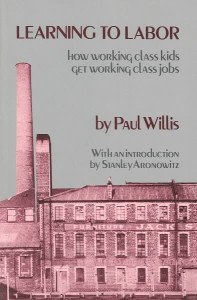A Reflection on the Educational Fallacy We Still Promote in Schools Today
The cover isn’t thrilling. The book is old (originally published in 1977), but goodness, it is still relevant. For those of you who missed this book the first time it came out, I will start with a brief synopsis. Paul Willis interviewed 12 “non-academic,” working class lads in Great Britain. He wanted to learn more about their subscription to a counter-culture and also was curious about their lives after school in the work force. These are the kids who smoked next to the school just to be seen smoking. They drank during lunch just out of defiance of the school. We know “these kids,” and they exist in every high school.
Willis found that regardless of their resistance to join the system, in the end, they ended up right where the system wanted them—in working class jobs in factories. He examines the masculinity perceived in these jobs, and he interviews the lads after they’ve entered the work force, too. He describes the optimism in the lads’ situation. They are very creative in the ways they thwart the school system. They say they’d never want office jobs or “mental labor.” The pessimism of their situation is the fact that the school system does not provide the upward mobility it claims to provide. They end up in “meaningless” jobs that offer them little pay.
When we tell students today to just do their best and work hard and that they will be successful, are we promoting an educational fallacy? We know that higher graduation rates will not produce more quality job opportunities for all. So why do we pretend that each student in our classes has an opportunity to be in a high-paying, “meaningful” job? Willis describes the ways that schools promote classism. Working class kids are prepared for working class jobs. (Obviously, we don’t technically have a working class anymore, but we can still find parallels in our school systems and job opportunities.)
Essentially, Willis describes how only a few individuals from these schools will end up in “meaningful” (according to culture’s standards) jobs, but the whole working class could never have upward mobility. The economy secures this disappointing truth, and without more opportunities, most of these students are destined for jobs in industrial factories. I was disturbed by how relevant this is to schools and jobs today. These lads’ refusal to cooperate in school (as a part of the “counter-school” culture) actually shows their refusal to collude with their own educational suppression. Willis depicts this beautifully. Those students who refuse to participate in lower-class schools may, in fact, have a perspective that is superior to that of the school. They understand, perhaps, that only a few students will make it in meaningful jobs, and they perceive these jobs to be unsatisfying, as well.
While I don’t believe I am as wholly pessimistic as Willis is, I think his points are valid and true. To what extent are we lying to students and promising them jobs that aren’t there? How do we fix this? Can it start in the ways we design schools, or must we rely on the political system? By teaching students about the power of education, I believe we are presenting them with opportunities they can or cannot choose to take. It is my hope that we can devise a system that opportunities truly exist for all who want them, rather than those hardworking, lucky few.

